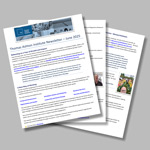Resources
As the work of the Institute grows, we are building a repository of our research. Updates will include new evidence statements, briefings, journal papers, and more, aimed at policymakers, businesses, health and safety professionals, and researchers.
To explore more research, insights, and practical tools on workplace safety, risk, and regulation, visit our profile on the University's research explorer.
-

Systematic review of the method and frequency for undertaking workplace respiratory health surveillance
Early identification of work-related respiratory disease (WRRD) is associated with improved health outcomes and benefits for other workers. Respiratory health surveillance (HS) is a scheme of repeated health checks used for the early identification WRRD. Health and Safety law in Great Britain requires employers to implement HS when workers remain exposed to health risks even after exposure mitigation measures have been put in place. This research was commissioned to systematically review and consider any evidence that relates to respiratory HS to ensure that HSE’s guidance on HS remains relevant and appropriate.
Read the report
-

Women’s health in The BMJ: a data science history
This BMJ Open study uses data science to trace how women’s health has been represented in medical research from 1948 to 2018, revealing key gaps and trends.
Read the paper
-

Semantic Annotation for Improved Safety in Construction Work
This study explores how semantic annotation and natural language processing can enhance safety in construction by improving the analysis of incident reports.
Read the paper
-

Work relationships, sense of purpose, perceived workload, and positive emotions towards work engagement of project professionals
This study explores how work relationships, sense of purpose, and perceived workload influence positive emotions and work engagement among project professionals.
Read the paper
-

Improving BIM asset and facilities management processes: a Mechanical and Electrical (ME) contractor perspective
This study examines how BIM can enhance asset and facilities management from the perspective of mechanical and electrical (ME) contractors, identifying key process improvements.
Read the paper
-

Construction Safety Training: what role can virtualized technologies play
This study investigates how virtualized technologies—like VR and AR—can enhance construction safety training, offering immersive and effective learning experiences.
Read the paper
-

Project and programme research centres: Lessons for scholarship, policy, and practice
This APM report maps global project and programme research centres, offering insights into how they bridge scholarship, policy, and practice to support better project delivery.
Read the report
-

An empirical study of assurance in the UK government major projects portfolio: from data to recommendations, to action or inaction
This empirical study examines how assurance processes function within the UK Government Major Projects Portfolio, revealing gaps between data, recommendations, and actual implementation.
Read the paper
-

Framing risk and uncertainty in the context of projects: Perspectives on decision-making
This paper explores how risk and uncertainty are framed in project contexts, offering insights into how these perceptions shape decision-making and project outcomes.
Read the paper
-

60 Seconds with…David Glass, Health and Safety Executive
David Glass of the Health and Safety Executive discusses the challenges and opportunities of using Additive Manufacturing in high-hazard sectors like petrochemicals.
Read the article
-

On Thresholds for Dynamic Strength in Solids
This review explores how solids respond to dynamic shock loading, identifying thresholds where materials transition from elastic to homogeneous flow and reach their theoretical strength.
Read the paper
-

4D micro-scale, phase-contrast X-ray imaging and computed tomography of HMX-based polymer-bonded explosives during thermal runaway
This study investigates the fire performance of concrete-filled steel tubular columns under elevated temperatures, offering insights into structural resilience in fire condition.
Read the paper
-

Contributions to Dynamic Behaviour of Materials Professor John Edwin Field, FRS 1936–2020
This tribute article honours Professor John E. Field’s pioneering contributions to high-strain rate physics, including impact, shock, and fracture mechanics in materials.
Read the paper
-

The Shock Induced Mechanical Response of the Fluorinated Tri-polymer, Viton B
This study investigates the shock-induced mechanical response of Viton B, a fluorinated tri-polymer, revealing how molecular structure influences stress, velocity, and shear strength under extreme condition.
Read the paper
-

4D synchrotron X-ray microtomography of fracture in nuclear graphite after neutron irradiation and radiolytic oxidation
This study examines the thermal and mechanical behaviour of ultra-high-performance concrete under elevated temperatures, offering insights into its fire resistance and structural integrity.
Read the paper
-

Advances on mode I fracture testing in brittle and quasi-brittle materials with x-ray tomography
This study uses X-ray computed tomography and Digital Volume Correlation to track plastic deformation in nuclear graphite, offering new insights into material failure mechanisms.
Read the paper
-

Material effects on the spallation response of metals and alloys
This article presents experimental insights into the dynamic response of materials under high strain rates, contributing to the understanding of shock physics and material strength.
Read the article
-

Fixing the HGV driver shortage
This blog from Alliance MBS highlights how improving the health and wellbeing of HGV drivers is key to solving the UK’s driver shortage, beyond just pay and policy fixes.
Read the blog
-

The rise of work-related violence and aggression
This blog explores the rise in work-related violence and aggression, especially during COVID-19, and highlights the need for better reporting and support for frontline workers.
Read the blog
-

Work-related violence and aggression: Don’t accept it. Report it. Prevent it.
This article highlights the growing issue of work-related violence and aggression, urging employers to take action and support staff through better reporting and prevention strategies.
Read the article
-

Changing worlds of work and occupational health: Insights on working into older age
The article highlights the growing trend of older adults remaining in the workforce and the associated occupational health challenges, particularly in sectors like logistics and transport. It emphasizes the need for proactive strategies to manage musculoskeletal disorders and mental health issues as the workforce age.
Read the article
-

Transport and logistics during the COVID-19 pandemic
The article discusses the health and safety implications of an ageing workforce, particularly in the logistics and transport sectors, where musculoskeletal disorders and mental health issues are prevalent. It emphasizes the importance of foresight and proactive planning to support older workers in adapting to evolving workplace demand.
Read the article
-

Workplace team resilience: A systematic review and conceptual development
This study reviews and synthesizes existing research on workplace team resilience, highlighting its distinct role beyond individual resilience in helping teams adapt to adversity. It proposes a new multilevel model that clarifies how individual and team-level resilience interact, aiming to guide future research and practical application.
Read the paper
-

Reducing workplace accidents through the use of leadership interventions: A quasi-experimental field study
This study investigates how psychological resilience can buffer the effects of stress in Chinese adolescents. It finds that higher resilience is significantly associated with lower levels of psychological distress, highlighting its protective role.
Read the paper
-

A Feasibility Study for Developing an Occupational Exposure-Control Intelligence System in Great Britain (using Respirable Crystalline Silica as the Working Example)
The report explores the development of a data-driven system (OccECIS) to monitor and manage occupational exposure risks, using respirable crystalline silica as a case study. It assesses existing data sources, technical feasibility, and stakeholder needs to inform future strategies for reducing work-related respiratory diseases.
Read the report
-

Thomas Ashton Institute Newsletter – June 2025
Download the newsletter
-

Occupational differences in COVID-19 incidence, severity, and mortality in the United Kingdom: Available data and framework for analyses
The article reviews existing UK datasets to assess how COVID-19 risks vary by occupation, highlighting elevated risks in healthcare and public-facing roles. It proposes a framework for analysing occupational exposure and outcomes, noting limitations in data quality and consistency.
Read the article
-

Respiratory health and silicosis in artisanal mine workers in southern Brazil
This review examines occupational exposure to PFAS across various industries, revealing that there a high prevalence of silicosis and other associated diseases in mining workers is associated with both unhealthy work environment conditions and the health profile of workers. This study is an important step for understanding health outcomes from work in ASM.
Read the article
-

Insufficient respiratory hazard identification in the safety data sheets for cleaning and disinfection products used in healthcare organisations across England and Wales
The study analysed data from over 900,000 NHS staff to assess COVID-19 risk by occupation during the first pandemic wave. It found the highest risks among patient-facing roles—especially care assistants, nurses, and allied health professionals—with odds ratios ranging from 1.5 to 2.5 compared to administrative staff.
Read the report
-

Characterising the landscape of UKRI funded national security and resilience research
The University of Manchester’s SALIENT initiative has released a working paper titled “Characterising the Landscape of UKRI Funded National Security and Resilience Research. The paper offers a detailed analysis of the UKRI-funded research landscape, and identifies key gaps, thematic imbalances, and opportunities for interdisciplinary collaboration.
Read the paper
-

Toward Cultural Change in the Construction Sector
This paper outlines a bold vision for transforming the UK construction sector by addressing deep-rooted cultural issues exposed by the Grenfell tragedy. It calls for a shift beyond regulatory compliance toward a more integrated, socially informed approach to building safety.
Read the paper
-

COVID-19 National Project resource bank
The resource bank shares updates, findings, and sector-specific insights from the PROTECT COVID-19 National Core Study, which investigates how SARS-CoV-2 spreads in different environments and workplaces. It supports evidence-based policy by offering practical tools, reports, and news on transmission risks, mitigation strategies, and lessons for future pandemic preparedness.
Explore the resource bank website
-

SALIENT Hub News and Resource Bank
The SALIENT Hub shares updates, research outputs, and funding opportunities from its interdisciplinary programme focused on building a secure and resilient UK. It highlights collaborative projects, policy-relevant findings, and innovations across themes like infrastructure, governance, and community resilience.
Explore the SALIENT Hub







